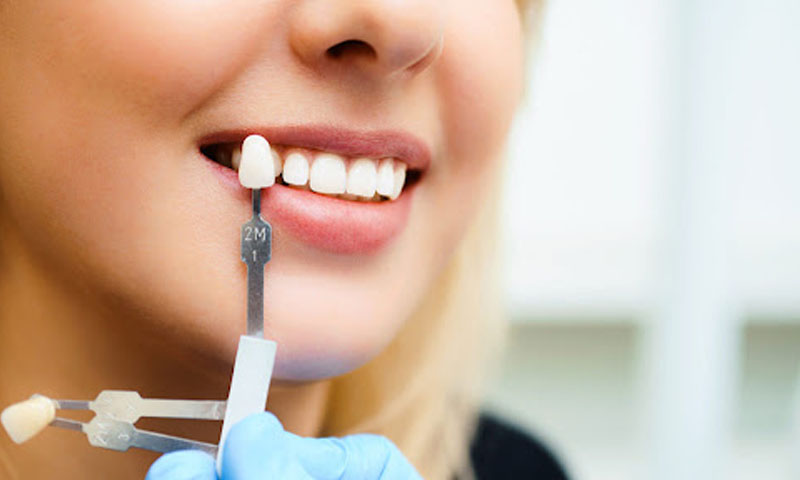Prosthetic dentistry
Modern dental prosthetics is a complex of methods for restoring dentition in elderly patients and in young people who have lost their teeth for various reasons.
All types of dentures are carried out in our clinic. Modern technology allows to accurately and quickly pick up the ideal size, color, and shape of the new tooth. Today, dental prostheses are durable, comfortable, and have a high cosmetic effect.
Dental prosthetics can be 2 types: removable and non-removable. The names speak for themselves – fixed prostheses are installed for permanent wearing, and removable ones can be removed from the oral cavity.
Prosthetic dentistry
Modern removable dentures are radically different from the old removable dentures that our grandparents had. Indentures, new flexible, durable, and safe materials are now being used. To manufacture such prostheses, technologies are used that make it possible to make a prosthesis with high accuracy. Thanks to this, it will suit you 100%. Tooth removable dentures are used for partial or complete loss of teeth. In the first case, this is especially true of the absence of chewing teeth or even the loss of one chewing tooth.
Fixed dentures are various designs of designs from one or more artificial teeth that become replaced by missing teeth. They are attached to neighboring healthy teeth with the help of various fixing elements (tabs, crowns, locks). a separate line of non-removable prosthetics is dental implantation.
Now in prosthetics, the most popular directions are cermet, clasp prosthesis, metal-free ceramics.
Metal Ceramics
Metal-ceramic dental crowns (or cermets) are a usual metal crown with ceramic lining. This type of prosthetics is used when a large degree of tooth decay allows ensuring the strength of the structure only with the use of a rigid, and at the same time lightweight cast metal frame. Metal ceramic can be installed on the back and front teeth. With the help of metal-ceramic crowns, the clinic “Aesthetic Dentistry” will restore even significantly damaged teeth.
The manufacture of a metal-ceramic crown occurs in this sequence: first, the dental technician creates a metal frame that exactly matches the contours of the tooth prepared for prosthetics. The frame is the most important element of the ceramic-ceramic crown design. That is why it uses alloys of precious metals (gold and palladium, gold and platinum) or titanium alloys to achieve the maximum quality during production.
Then, a porcelain veneer is applied layer by layer on the metal frame. In this case, the shade of porcelain can be chosen so that it does not even differ in color from the rest of the teeth. Crown, made in this way, has excellent aesthetic properties-it looks like a healthy real tooth. In addition, it is very durable and durable.
Metal-free ceramics
Nonmetallic ceramics – in cosmetic dentistry the latest achievement. As the name implies, the crown of this material is made without metal content. Ie, unlike the cermet, which is a metal cap lined with a ceramic coating, the metal-free ceramic is completely made of porcelain. This feature determines the main positive properties of non-metal ceramics. Why does this technology attract such attention?
The non-metal ceramic allows producing reliable, light, and aesthetic dentures. This technology is now recognized by the world’s leading dentists as the safest. Porcelain – the material is inert and it practically does not affect its environment. Therefore, metal-free ceramics are absolutely safe for the human body. Crowns made of non-metal ceramics are created strictly in accordance with the color and shape of the patient’s teeth. For any person, the aesthetic properties of the denture are very important. And here it is metal-free ceramics that can show itself from the best side.
The light-free ceramic is translucent, like a real tooth. The degree of refraction of light in non-metal ceramics is the same as that of tooth enamel. Externally, the crown, which is made of non-metal ceramics, taking into account the individual characteristics of the patient’s natural teeth, even for a very highly skilled dentist from the patient’s living tooth is indistinguishable. Thus, from the cosmetic point of view, the use of non-metal ceramics is an ideal variant of the material for tooth modeling. But, it must be noted that practicality in use is no less important than beauty. More recently, it was accepted that crowns of non-metal ceramics should be placed only on the front teeth and it was possible to apply it sooner only for aesthetic reasons.
The metal-free ceramic was previously not designed for heavy loads, which must be borne by chewing teeth, for example, during meals. But now in the manufacture of non-metal ceramics casting technology is used. Crowns, which are obtained in this way, are much stronger than those that were before. Metal-free ceramics is an ideal solution from the point of view of the dentist and the patient. Metal-free ceramics are therefore becoming increasingly popular all over the world.
Clasp prosthesis
The name “clasp prosthetics” – comes from the German bugel – arc. Interestingly clasp prosthesis of teeth in that it less injures the gums, compared with other methods of dental prosthetics. It is due to the fact that the clasp prosthesis when wearing is based not only on the gums, but also on healthy teeth. The dentist-orthopedist can recommend you clasp prosthetics, as it helps to recreate the closest to the physiological way of transmitting the masticatory load. Also, many will like the fact that the clasp prosthesis is durable, convenient and very compact. Modern orthopedic dentistry has huge opportunities for implanting teeth. This method of dental prosthetics does not require sharpening of healthy “neighbors”.





Let's Call You